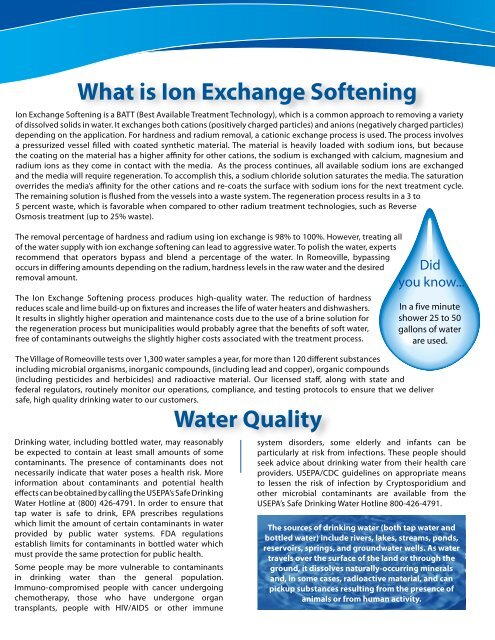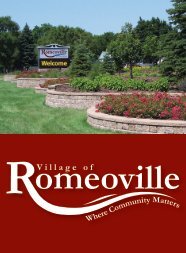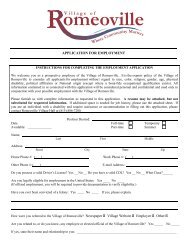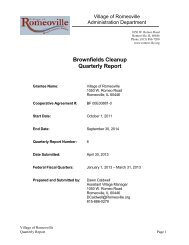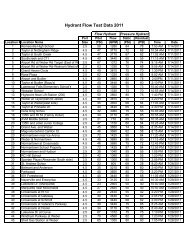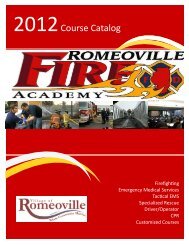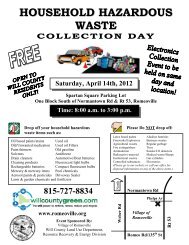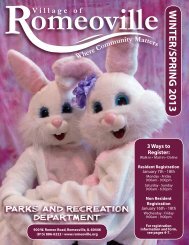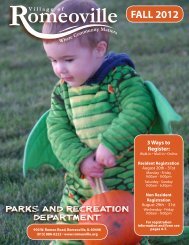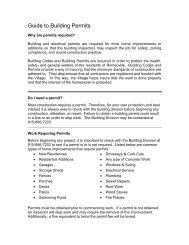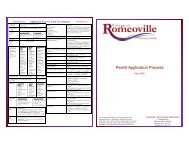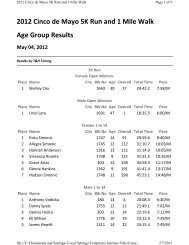2008 Water Quality Report - Village of Romeoville
2008 Water Quality Report - Village of Romeoville
2008 Water Quality Report - Village of Romeoville
Create successful ePaper yourself
Turn your PDF publications into a flip-book with our unique Google optimized e-Paper software.
What is Ion Exchange S<strong>of</strong>tening<br />
Ion Exchange S<strong>of</strong>tening is a BATT (Best Available Treatment Technology), which is a common approach to removing a variety<br />
<strong>of</strong> dissolved solids in water. It exchanges both cations (positively charged particles) and anions (negatively charged particles)<br />
depending on the application. For hardness and radium removal, a cationic exchange process is used. The process involves<br />
a pressurized vessel filled with coated synthetic material. The material is heavily loaded with sodium ions, but because<br />
the coating on the material has a higher affinity for other cations, the sodium is exchanged with calcium, magnesium and<br />
radium ions as they come in contact with the media. As the process continues, all available sodium ions are exchanged<br />
and the media will require regeneration. To accomplish this, a sodium chloride solution saturates the media. The saturation<br />
overrides the media’s affinity for the other cations and re-coats the surface with sodium ions for the next treatment cycle.<br />
The remaining solution is flushed from the vessels into a waste system. The regeneration process results in a 3 to<br />
5 percent waste, which is favorable when compared to other radium treatment technologies, such as Reverse<br />
Osmosis treatment (up to 25% waste).<br />
The removal percentage <strong>of</strong> hardness and radium using ion exchange is 98% to 100%. However, treating all<br />
<strong>of</strong> the water supply with ion exchange s<strong>of</strong>tening can lead to aggressive water. To polish the water, experts<br />
recommend that operators bypass and blend a percentage <strong>of</strong> the water. In <strong>Romeoville</strong>, bypassing<br />
occurs in differing amounts depending on the radium, hardness levels in the raw water and the desired<br />
removal amount.<br />
The Ion Exchange S<strong>of</strong>tening process produces high-quality water. The reduction <strong>of</strong> hardness<br />
reduces scale and lime build-up on fixtures and increases the life <strong>of</strong> water heaters and dishwashers.<br />
It results in slightly higher operation and maintenance costs due to the use <strong>of</strong> a brine solution for<br />
the regeneration process but municipalities would probably agree that the benefits <strong>of</strong> s<strong>of</strong>t water,<br />
free <strong>of</strong> contaminants outweighs the slightly higher costs associated with the treatment process.<br />
Drinking water, including bottled water, may reasonably<br />
be expected to contain at least small amounts <strong>of</strong> some<br />
contaminants. The presence <strong>of</strong> contaminants does not<br />
necessarily indicate that water poses a health risk. More<br />
information about contaminants and potential health<br />
effects can be obtained by calling the USEPA’s Safe Drinking<br />
<strong>Water</strong> Hotline at (800) 426-4791. In order to ensure that<br />
tap water is safe to drink, EPA prescribes regulations<br />
which limit the amount <strong>of</strong> certain contaminants in water<br />
provided by public water systems. FDA regulations<br />
establish limits for contaminants in bottled water which<br />
must provide the same protection for public health.<br />
Some people may be more vulnerable to contaminants<br />
in drinking water than the general population.<br />
Immuno-compromised people with cancer undergoing<br />
chemotherapy, those who have undergone organ<br />
transplants, people with HIV/AIDS or other immune<br />
<strong>Water</strong> <strong>Quality</strong><br />
Did<br />
you know...<br />
In a five minute<br />
shower 25 to 50<br />
gallons <strong>of</strong> water<br />
are used.<br />
The <strong>Village</strong> <strong>of</strong> <strong>Romeoville</strong> tests over 1,300 water samples a year, for more than 120 different substances<br />
including microbial organisms, inorganic compounds, (including lead and copper), organic compounds<br />
(including pesticides and herbicides) and radioactive material. Our licensed staff, along with state and<br />
federal regulators, routinely monitor our operations, compliance, and testing protocols to ensure that we deliver<br />
safe, high quality drinking water to our customers.<br />
system disorders, some elderly and infants can be<br />
particularly at risk from infections. These people should<br />
seek advice about drinking water from their health care<br />
providers. USEPA/CDC guidelines on appropriate means<br />
to lessen the risk <strong>of</strong> infection by Cryptosporidium and<br />
other microbial contaminants are available from the<br />
USEPA’s Safe Drinking <strong>Water</strong> Hotline 800-426-4791.<br />
The sources <strong>of</strong> drinking water (both tap water and<br />
bottled water) include rivers, lakes, streams, ponds,<br />
reservoirs, springs, and groundwater wells. As water<br />
travels over the surface <strong>of</strong> the land or through the<br />
ground, it dissolves naturally-occurring minerals<br />
and, in some cases, radioactive material, and can<br />
pickup substances resulting from the presence <strong>of</strong><br />
animals or from human activity.


